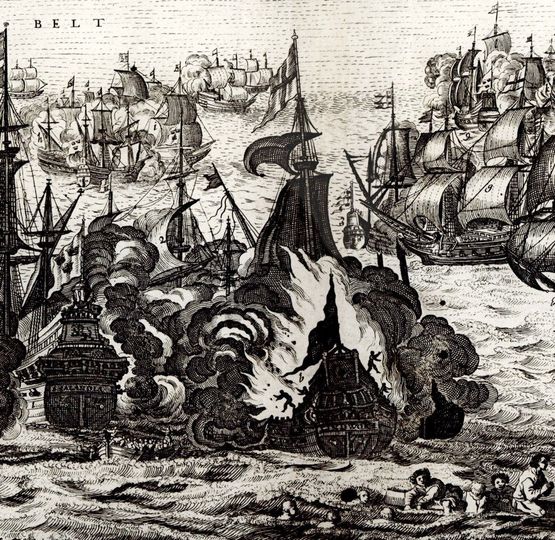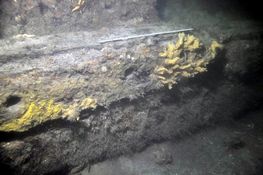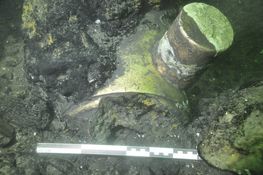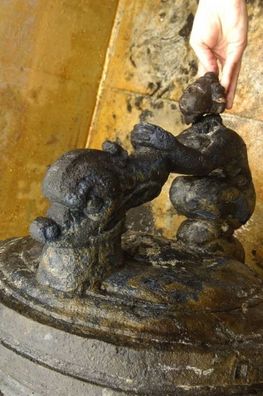Fight, fire and disaster
– the loss of the warship Lindormen in 1644 and its recent rediscovery
Senior researcher, Dr. Martin Segschneider, Head of Coastal and Maritime Archaeology at Lower Saxony Institute for Historical Coastal Research, Wilhelmshaven
For centuries, Fehmarn Belt has been an important strait and waterway. Several sea battles took place here in the 17th and 18th centuries, not least on the 13th October 1644, when a Danish command of 17 ships clashed with a fleet of 37 Swedish and Dutch ships.
The historical background for this confrontation was the Torstenson Feud (1643-1645), a struggle for economic and political supremacy in the Western Baltic Sea. The Torstenson Feud is best understood as part of the European Thirty Years’ War (1618-1648).
During the fierce engagement, many Danish ships were conquered. Other Danish ships were attacked by fire ships, and thereby ignited and subsequently lost. One of these lost ships was Lindormen, a three-master built in 1626, in Itzehoe. With a length of 38.2 m and a width of 8.8 m, the man-o`-war carried 38 guns and had 200 to 300 men aboard.
Any knowledge of the position, where Lindormen sank, vanished through the centuries. However, in 2006/2007, underwater surveying within an obstacle zone approximately three kilometres north of Puttgarden produced the first hint that this could be an important historic wreck site.
Due to the planned construction of the Fixed Link connection between Denmark (Lolland) and Germany (Fehmarn) the wreck site came into focus, as it was within the area where authorities had to carry out an Environmental Impact Assessment, including submerged cultural heritage. Both the State Archaeological Office of Schleswig-Holstein and the Viking Ship Museum in Roskilde co-operated closely, using common standards from coast to coast, to fulfil this task in the area in question. Jørgen Dencker from the Viking ship Museum in Roskilde served as co-ordinator of the project.
Substantial surveying confirmed that the wreck was an important cultural monument, and thus protected by law. In order to establish a fitting protection plan, the identification of the ship, the extent of the wreck-site and the ship’s state of preservation came into question. Hence, from May to July 2012, the Danish dive vessel Vina, anchoring close to the wreck, serving as a working base. Twelve-hour diving per day followed, with divers/archaeologists using Nitrox gas and water-heated suits to be able to investigate and document the wreck site at 25 m water depth.
The remaining hull of the vessel measured around 32 m in length and more than 8 m in width. Although a fierce fire had destroyed much of the interior of the ship, it was possible to locate the galley in the central part of the vessel. The wreck was scattered with parts from the sails and rigging, that had fallen down burning, before the ship sank. The infernal fire caused many of the bronze guns to melt, to crack or to bend.
Inscriptions and decorations reveal the guns’ place of manufacture to be Helsingør, between 1604 and 1629. Manifold associated cast-iron shots were also found within the hull of the wreck. There were also many wooden finds, all with fire-marks: barrels, parts of furniture like sea-chests as well as small items like boxes and cans to store precious and fragile objects. Clay pipes, which according to their shape, decoration and markings date to around 1630, represent the few personal belongings of the sailors.
Putting it all together, we can date the sinking of the ship between 1630 and 1650, keeping in mind that the bronze guns clearly characterise the ship as a Danish Man-o´-War. In line with the extensive traces of burning and the size of the hull, everything points to the fact that the wreck is indeed the vanished Lindormen!
As such, the wreck meets the criteria for being coined as a significant underwater monument. Even though a lot of objects were excavated and salvaged the majority of the ship components and other objects remains at the wreck site. Wood-deteriorating organisms like the shipworm (Teredo navalis) and gribble (Limnoria lignorum) are damaging the remaining ship components, and the consulted experts, including the Danish National Museum, recommended a full coverage of the wreck as the only efficient way to protect against further deterioration. Therefore, with the support of Femern A/S, it was decided to place a substantial hill of sand over the wreck and top this with coarse gravel, thereby creating a stable, artificial reef.
The results of the archaeological project, are striking: we managed to identify, scientifically document and protect the rediscovered warship Lindormen. This was an extraordinary project, one you most likely only will bump into once in a lifetime, and that is if you are lucky! But also one, which caused sleepless nights, worrying if everything was being conducted the right way in order to fully utilise this rare opportunity to show the potential of underwater archaeology and get in touch with history!
Read more:
Segschneider, M. 2014. Verbrannt und versunken – das Wrack Lindormen im Fehmarnbelt. Archäologische Nachrichten Schleswig-Holstein 20, 2014, 88–93.
» Find the report 'Archaeological investigation of the Danish warship Lindormen, lost in 1644' here.




![[Translate to english:] Udstillingen 'I Røg og Brand' på Vikingeskibsmuseet](/frontend/Grafik/rog-og-brand-lille-side-banner-07.jpg)
![[Translate to english:] Udstillingen 'I Røg og Brand' på Vikingeskibsmuseet](/frontend/Grafik/rog-og-brand-lille-side-banner-04.jpg)
![[Translate to english:] Udstillingen 'I Røg og Brand' på Vikingeskibsmuseet](/frontend/Grafik/rog-og-brand-lille-side-banner-05.jpg)